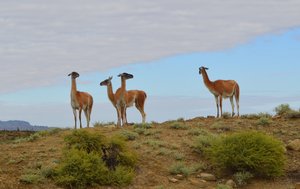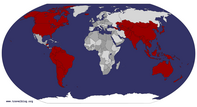Advertisement
Published: March 8th 2018

 Guanacos
Guanacos
A relative of the llama, a common sight alone the road.We left Barreal after the best breakfast we have had in Argentina, fresh baked bread and pastry (with apples from the trees in the yard), coffee, cereal, meat, cheese and at least four types of home made preserves. We were continuing on north, and had a hard time making any time as it seemed that every five or ten miles we needed to stop and take another picture of the mountains showing yet another side of their beauty.
We had pretty good roads as far as Calligasta and then we were in for a treat...some 30K of roads that barely held on to the hillside, and were often covered with shale or mud from the heavy rains the day before. It seemed there was heavy equipment everywhere, whose main job was to shovel the debris from the road. When we emerged from the canyon that we had been driving we hit a terrific brand new road that took us almost all the way to Route 40, the national north/south road that was the genesis of this trip (I have wanted to drive the entire thing, but will have to settle to just doing select bits).

 The old mill in Huaco
The old mill in Huaco
The poet and the descendent of the builder.We passed up a posada, big mistake, and blasted off to the north on what turned out to be a pretty interesting road that passes through no towns for hundreds of kilometers with nary a empanada stand in sight! We finally got to Jackal and stopped at the first round about for a snack. We asked about Jackal and Huaco, and made one of the smartest decisions so far and headed to the tiny town of Huaco without a reservation for the night.
It took a bit, but once there we found Hosteria Huaco and walked in on the owner, Francois, closing the deal to rent the place to a new manager! They were happy to rent us a room and provide dinner for the night (for the grand total, with breakfast, of about $50US) but, before we did that, would we like to take a tour of the area with Francois, his American wife Elizabeth, 18 month old Banyan and the new management team. But of course. (They also loved it that I knew the joke....when Argentines ask us where we are from we say Ohio and they say, "Ohio, why are you so sad?" Turns

 Petroglyphs in Talampaya
Petroglyphs in Talampaya
Trip to Argentina on me if you can read themout a former president who was one of the most corrupt never learned Spanish well and mispronounced the word for sad as "Ohio".....OK, guess you had to be there.)
Our first stop was the old wheat mill, built by an Welsh guy back in 1780. It was in operation until 1968, still powered by water. The place is tended by a woman who is a descendent of the builder, and she took us around, explaining all the operations...which I would have understood more of had it been in English! But I got enough and then the highlight of the day....the new manager of the Hosteria is also a bit of a poet, and he had written a poem about this mill comparing it to the mill in Cervantes Don Quixote. He stood in the shadows of the mill and recited for us all, I could not understand a word, but the beauty of the sound was all that really mattered.
That night at dinner we had home made goat stew, slowly cooked in a red wine sauce, accompanied by, of course, a bottle of red that we had brought with us from Mendoza. We

 Talampaya
Talampaya
In the canyon.shared a glass with Elizabeth who filled us in on what we should see in San Juan later this week as that is where she and Francois live.
Tuesday we were up and out a bit earlier, headed for two national parks...Talampaya and Valle de Luna. Due to the rain remember the washed out roads, they had been closed over the weekend and through Monday.
The drive was on the newly built Route 150, it does not show up on most printed maps of the country. The first 10K again you are agog over the foothills of the Andes scenery. Then you hit about 80K of dead straight road that grinds through the valley floor that had been scoured by glaciers leaving nothing but a bit of soil resting on solid rock. Here you can see the reason for the damaging floods from the rain--the water cannot penetrate and simply skates over the clay (from the sandstone cliffs) and spreads out to cover the entire valley. Now the mountains that have been looming before you suddenly reveal a small pass into which the road darts and starts to climb. Up one side, down the

 Talampaya
Talampaya
The canyon rises above you, you do not descend into it.other, through tunnels, over bridges, until you take a steady climb to the top of the mountains with more switch backs than you can count and exit out onto, as hard as it is to believe, another plain. This flat uplift was not susceptible to erosion due to its make up and so again we take off on a dead straight road until we reached the parks.
Only Talampaya was open on Tuesday and we booked a trip on the 1 p.m. tour. You can only visit the park with a tour, and you can see why when you get there. The four wheel drive takes you in via a valley between cliffs that tower 300 meters above you. The valley is a river bed when it rains, and it was still swampy from the weekend torrents. We saw petroglyphs, wind and water eroded formations, wildlife, and heard our voices echo up and down the canyon when we spoke in more than whisper. It was a hard place to take in, and hard to leave as well.
Tuesday night we landed in the half-horse town of Bade Rosario. Bill found a great little place,

 Dinosaur
Dinosaur
Actual excavation in Valley of the Moonfour rooms on a farm with chickens and dogs and turkeys and horses running around, a fridge full of beer and, despite what the booking service said, no charge for towels.
On Wednesday we hit "Valle de Luna". Along with Talampaya this makes up a giant biosphere reserve. The name, valley of the moon, is only a nickname. The actual name of the place is "Dead Land" in the indigenous people's language. It's big draw is that the sandstone erodes down a few inches every year revealing dinosaur bones. It is an eerie place, we drive in a caravan of cars right through it, with the guide in the lead car. There are several stops, including a museum they have built right over an actual dig site. We also stopped on the edge of the valley where the white sandstone gives way to towering peaks of red sand stone. It seems that when the Pacific and South American plates collided to form the Andes the force both flipped and pushed up three layers of long buried sea floor...thus the heaviest and deepest (the red) surfaced first followed by the white (which makes up the valley) and then

 The Mushroom
The Mushroom
The iconic formation in Valley of the Moonyellow (the youngest but now underneath the other layers. The tilt of the formation caused the layers to slide off one another to the north, thus the three colors and the heavy, denser, red clay cliffs. OK, I'm not sure I get all this either. Trust me when I say it was almost too much to comprehend.
One more note about the Valley of Moon, you travel in your own car but the guide asked us, being friendly types, if we would mind a passenger. Why not? Turns out it was a guy from Poland who was spending a year seeing South American...on his bicycle! You'll just have to imagine the tales he had to tell...including traveling 25Km per hour without peddling while in Tierra del Fuego as he was pushed along by the winds. When we last saw him he was peddling in the direction of Bolivia.
We thought the day was over, nothing left but the drive to San Augustine where we were spending the night. But once we arrived we found out about two organic farms that we decided to visit. The first was Finca Don Antonio and when we pulled

 Oscar Sanchez
Oscar Sanchez
The owner and guardian of the organic farm Don Amelioup the young woman who was cleaning simply walked us to the vineyard and said we could look around. When walking through the vines we heard voices and followed them to find Daniel Sanchez, the owner, picking grapes with two other workers. What followed was a nearly two hour tour as he showed us how he grew grapes, corn, mendriajo (like a large quince that they make jams and a large gelatin block that can be sliced and eaten with cheese), garlic, and more organically. He also makes biodiesel from the stems of the grapes and uses the skins and seeds left over from making the wine to make a gluten free flour for baking! Then we were invited into his production room where he explained how he makes organic wines and, of course, this led to sitting down for a tasting. Was it the place, the day, or the man that made this the best tasting Malbec I have ever enjoyed.
Next stop was an organic olive farm just down the road. Here Rodrigo, the owner of Finca Elsa (named for his daughter) walked us through the olives and talked us through his processes of making

 Tractor
Tractor
This is how you bring in grapes on an organic farm!olive oil and olive oil salves.
We head to the capital of the province, the city of San Juan, next.
Advertisement
Tot: 0.27s; Tpl: 0.014s; cc: 14; qc: 76; dbt: 0.0903s; 1; m:domysql w:travelblog (10.17.0.13); sld: 1;
; mem: 1.2mb














